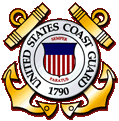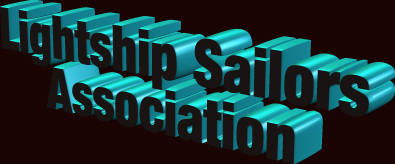



![]()



![]()
![]()
REFLECTIONS OF AN OLD “COASTIE”
(active duty ‘54 to ‘56 as MM3)
Let me begin these reflections as they began. Not wanting to be in the Army, my cousin who was a USCG recruiter at the time, convinced me to join he USCG Reserves. After a year of reserve duty, I could request two years of active duty and be done. So, that is what I did.
NOTE: Click on picture (left) to enlarge.
(Note, many of the photos included here are are of rather low quality - this is because they were captured from old 8mm movie film - 50 year old film! The photo of the ship is actually of her sister ship, the San Francisco, with the writing changed and color added)
You might imagine my surprise when I reported on board at the Blunts Reef Station and discovered, in the bow of the ship, this 1904 bell! (U. S. L. H. E. Stands for U. S. Light House Establishment). The LV76, then known as the WAL504 was an old ship - a very old ship, it may have been the oldest active ship in the fleet. Other things led to the conclusion that I was not on a new ship.
The decks (all of them) were of teak wood. The deck houses were wooden, had conventional landlubber type doors and windows (no port holes!). My suspicions were right as she was decommissioned five years later.
One of the first views I had of her was this one taken from the cutter which took us out to the light station - Bluntz Reef.
At the time I took this photo, I had no idea of how I was going to get “from here to there!”
I soon learned that the mode of transportation was the lightship’s 26 foot motor-lifeboat shown here coming aside the tender. On calm days, the process was rather easy. On rougher days it was somewhat dangerous. One very rough day, which I’ll discuss later, it was very dangerous.

Well, I was finally in the life boat and on my way to the “504." As this photo shows, the sea was not calm. I was quite sea sick at the time and didn’t enjoy the trip at all.

As we drew closer I could see the lights on the after mast, the fog horns (forward mast just above the pilot house), and other features of the ship.
Once we are
all aboard, the tender was on its way back the Field’s Landing (south of
Eureka), it was time to look over the crew. So it was time for a personnel
inspection. We had very few of these and, most of the time, I managed to
be on Engine Room Watch and couldn’t participate. As one may see from the
photo, there were about nine men in the inspection. Add the Radio Room
Watch and the Engine Room Watch and you get eleven. This was about the
normal number of men on board while on station.
There were two of us that were new - one for the deck force and one for the “black gang.” Fortunately (in my opinion) I was assigned the “black gang” (the deck force called us “snipes” and worse than that). So, I learned to be a Machinist Mate. I also learned to be a Electricians Mate, and Electronics Technician, a Boiler Tender, etc., etc., etc. We such a small engineering force, we had to be able to handle all sorts of work.
I enjoyed most of the work. Since I had learned electronics

and mechanics on my own before entering the service, I was assigned a rather wide range of duties. There was one job which fell under my jurisdiction that I did not enjoy - the diaphones (fog horns, see one in photo to the right). The copper tubing that controlled them would work-harden and, eventually break. Then it was time for me to go to work. If there was only one horn, it would be alright - there were two. One would continue to blast away as I climbed the forward mast to fix the other. Cotton in the ears, watch cap over them, and other remedies didn’t seem to help much - it was LOUD up there!
![]() Yes! There is MORE! Next Page.
Yes! There is MORE! Next Page.

Copyright © 2004 United States Coast Guard Lightship Sailors Association
INC. All rights reserved.
Copyrights also protected by the
Digital Millennium Copyright Act of
1998
Revised: 10/23/06.